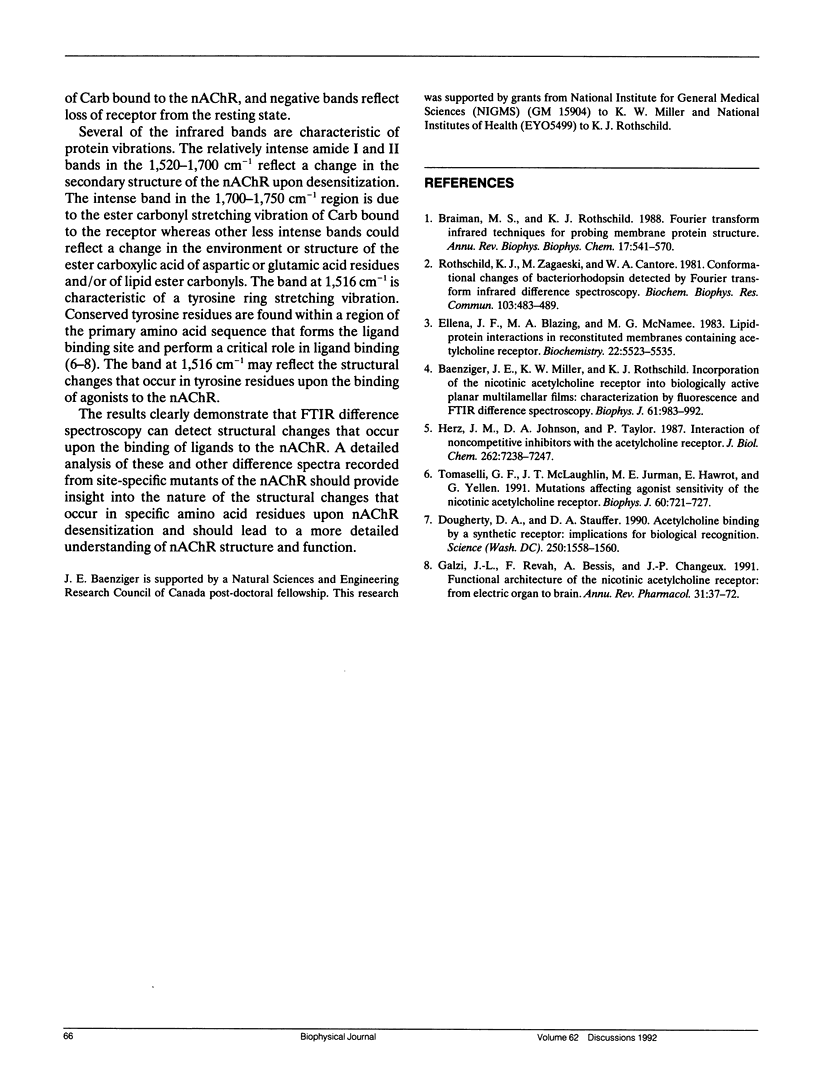Abstract
We have developed a Fourier transform infrared (FTIR) difference method for probing conformational changes that occur upon the binding of ligands to the nicotinic acetylcholine receptor (nAChR). Our approach is to deposit reconstituted nAChR membranes in a thin film on the surface of a germanium internal reflection element, acquire FTIR spectra in the presence of bulk aqueous solution using attenuated total reflection, and then trigger conformational changes by sequentially flowing a buffer either with or without an agonist past the film surface. Using the fluorescent probe, ethidium bromide, it is demonstrated that the method of nAChR film deposition does not affect the ability of the receptor to undergo the resting-to-desensitized state transition. The difference of FTIR spectra of nAChR films recorded in the presence and absence of agonists reveal highly reproducible infrared bands that are not observed in the difference of spectra recorded with only buffer flowing past the film surface. Some of the bands are assigned to changes in protein secondary structure and to changes in the structure of individual amino acid residues. Bands arising from the vibrations of the agonist bound to the receptor are also observed. The results demonstrate that FTIR difference spectroscopy can detect structural changes in the nAChR that occur upon the binding of ligands. The technique will be an effective method for investigating nAChR structure and function as well as receptor-drug interactions.
Full text
PDF


Selected References
These references are in PubMed. This may not be the complete list of references from this article.
- Braiman M. S., Rothschild K. J. Fourier transform infrared techniques for probing membrane protein structure. Annu Rev Biophys Biophys Chem. 1988;17:541–570. doi: 10.1146/annurev.bb.17.060188.002545. [DOI] [PubMed] [Google Scholar]
- Dougherty D. A., Stauffer D. A. Acetylcholine binding by a synthetic receptor: implications for biological recognition. Science. 1990 Dec 14;250(4987):1558–1560. doi: 10.1126/science.2274786. [DOI] [PubMed] [Google Scholar]
- Ellena J. F., Blazing M. A., McNamee M. G. Lipid-protein interactions in reconstituted membranes containing acetylcholine receptor. Biochemistry. 1983 Nov 22;22(24):5523–5535. doi: 10.1021/bi00293a012. [DOI] [PubMed] [Google Scholar]
- Galzi J. L., Revah F., Bessis A., Changeux J. P. Functional architecture of the nicotinic acetylcholine receptor: from electric organ to brain. Annu Rev Pharmacol Toxicol. 1991;31:37–72. doi: 10.1146/annurev.pa.31.040191.000345. [DOI] [PubMed] [Google Scholar]
- Herz J. M., Johnson D. A., Taylor P. Interaction of noncompetitive inhibitors with the acetylcholine receptor. The site specificity and spectroscopic properties of ethidium binding. J Biol Chem. 1987 May 25;262(15):7238–7247. [PubMed] [Google Scholar]
- Rothschild K. J., Zagaeski M., Cantore W. A. Conformational changes of bacteriorhodopsin detected by Fourier transform infrared difference spectroscopy. Biochem Biophys Res Commun. 1981 Nov 30;103(2):483–489. doi: 10.1016/0006-291x(81)90478-2. [DOI] [PubMed] [Google Scholar]
- Tomaselli G. F., McLaughlin J. T., Jurman M. E., Hawrot E., Yellen G. Mutations affecting agonist sensitivity of the nicotinic acetylcholine receptor. Biophys J. 1991 Sep;60(3):721–727. doi: 10.1016/S0006-3495(91)82102-6. [DOI] [PMC free article] [PubMed] [Google Scholar]


